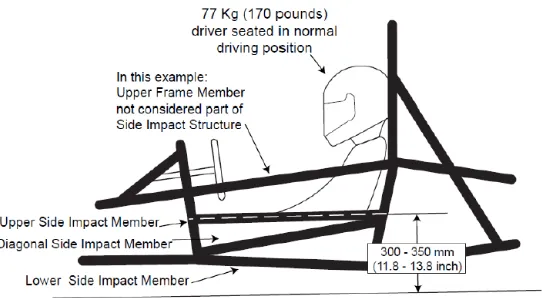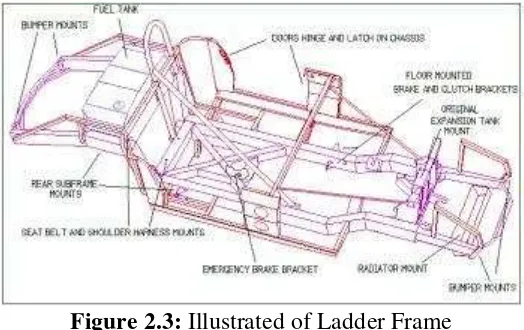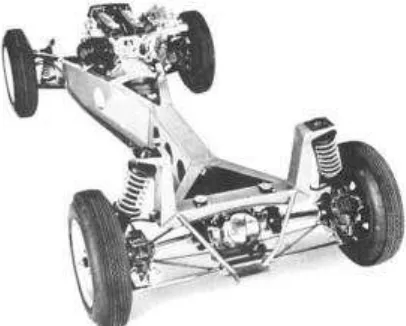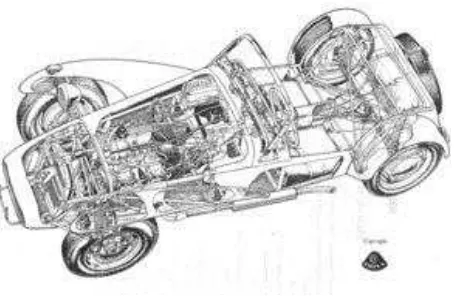DESIGN OPTIMIZATION STUDY ON THE FORMULA VARSITY CAR CHASSIS
MUHAMMAD SHUKRI BIN AHMAD AZAZI
“I hereby declare that I have read this thesis and my opinion this report is sufficient in terms of scope and quality for the award of the degree of
Bachelor of Mechanical Engineering (Design & Innovation).”
Signature : ………....
Supervisor : DR. ABD RAHMAN BIN DULLAH
DESIGN OPTIMIZATION STUDY ON THE FORMULA VARSITY CAR CHASSIS
MUHAMMAD SHUKRI BIN AHMAD AZAZI
This report is presented in
Partial fulfillment of the requirements for the
Degree of Bachelor of Mechanical Engineering (Design & Innovation)
Faculty of Mechanical Engineering Universiti Teknikal Malaysia Melaka
ii
DECLARATION
“I hereby declare that the work in this report is my own except for summaries and quotations which have been duly acknowledgement.”
Signature : ………
Author : MUHAMMAD SHUKRI BIN AHMAD AZAZI
iii
DEDICATION
“To my beloved parents Mr. Ahmad Azazi bin Che Hin
iv
ACKNOWLEDGEMENT
Alhamdullillah, thanks to Allah with it is consent I can finish this report for successfully. I also would like to thanks to Dr. Abd Rahman Bin Dullah and appreciative of his guide during the research I do and during prepare this report. Furthermore, many thanks to my collage friend especially my housemate because with them encouragement and support I can complete this Final Year Project report. Without their cooperation it is difficult to me to complete this report. Not forgotten to my beloved parents and family that always supporting and praying for my successful to complete my degree study. Finally, I would like to thanks to everyone have involved directly or indirectly in my research study until I finished this report.
Thank you very much.
vi
ABSTRACT
vii
ABSTRAK
viii
CONTENTS
CHAPTER ITEMS PAGE
DECLARATION ii
DEDICATION iii
ACKNOWLEDGEMENT iv
ABSTRACT v
ABSTRAK vi
CONTENTS vii
LIST OF TABLES x
LIST OF FIGURES xi
LIST OF ABBREVIATIONS xiii
LIST OF APPENDIX xiv
CHAPTER 1 INTRODUCTION 1.1 Background 1
1.2 Objective 2
1.3 Problem Statement 2
1.4 Scope 2
CHAPTER 2 LITERATURE REVIEW 2.1 Competition Rule 3
2.2 Types of Chassis Design 5
2.2.1 Ladder Frame 5
2.2.2 Space Frame 5
2.2.3 Backbone Chassis 6
2.2.4 Monocoque 7
ix
2.3.1 Tubular Steel Space Frame 8
2.3.2 Metal Monocoque 8
2.3.3 Composite Semi Monocoque 9
2.4 Types of Materials 9
2.4.1 Steel 9
2.4.2 Plain Carbon Steel 9
2.4.5 Alloy Steel 10
2.4.6 Stainless Steel 10
2.4.7 Aluminum 10
2.5 Stiffness Torsional 11
2.5.1 Longitudinal Torsion 11
2.5.2 Vertical Bending 12
2.5.3 Lateral Bending 12
2.5.4 Horizontal Lozenging 13
2.6 Optimization Methods 14
2.6.1 Topology Optimization 14
2.6.2 Topometry Optimization 14
2.6.3 Topography Optimization 15
2.6.4 Size Optimization 15
2.6.5 Shape Optimization 15
CHAPTER 3 METHODOLOGY 3.1 Project Flow Chart 16
3.2 Literature Review 18
3.3 Create Existing Design 18
3.4 Generate Idea 19
3.5 Package Space 19
3.6 Analysis and Optimization Method 20
3.1.1 Pre – Processing 21
3.1.2 Solving 21
x
CHAPTER 4 ANALYSIS AND OPTIMIZATION
4.1 Importing CAD Data 23
4.2 Shell Meshing 25
4.3 Linear Static Analysis for Existing Chassis Base 26
4.3.1 Analysis set up 27
4.4 Topology Optimization 33
4.4.1 Package Space 34
4.4.2 Create Mesh and Property 34
4.4.3 Set up the Design Variable 35
4.4.4 Creation of Response 36
4.4.5 Creation of Constraint 37
4.4.6 Define the Objective Function 38
4.4.7 Job Submitted 40
CHAPTER 5 RESULT AND DISCUSSION 5.1 Linear Static Result for Existing Chassis Base 42
5.2 Topology Optimization Result 42
5.3 Linear Static Result for Optimized Chassis Base 44
5.4 Comparison of Result 45
5.5 Discussion 46
5.5.1 To Generate Idea 46
5.5.2 Set up the Optimization Variable 46
5.5.3 Interpretation of the Result 47
5.5.4 Comparison of the Result 47
CHAPTER 6 CONCLUSIONS & RECOMMENDATION 6.1 Conclusion 48
6.2 Recommendation 49
REFERENCES 50
BIBLOGRAPHY 51
APPENDIX A 52
x
LIST OF TABLES
NO. TITLE PAGE
2.1 Range of plain carbon steel 9
5.1 Linear static analysis result for existing chassis base 42
5.2 Topology optimization result 43
5.3 Result for optimized chassis base 44
5.4 Comparison of maximum displacement result 45
xi
LIST OF FIGURE
NO. TITLE PAGE
2.1 Illustrated of side impact member 4
2.2 Illustrated of helmet clearance 4
2.3 Illustrated of Ladder Frame 5 2.4 Space frame chassis 6
2.5 Example of Backbone Chassis 6
2.6 Example of Monocoque Chassis 7 2.7 Longitudinal Torsion 11
2.8 Vertical Bending 12
2.9 Lateral Bending Deformation Mode 12
2.10 Horizontal Lozenging 13
3.1 Project Flow Chart 17
3.2 3D model of existing formula varsity race car chassis base 18
3.3 Chassis base with force and constraints 19
3.4 Chassis base with package space 20
3.5 Flow chart of workflow in the HyperWorks 22
4.1 Importing icon in the HyperWorks panel 24
4.2 Importing CAD 24
4.3 Existing chassis base CAD data in HyperMesh 24
4.4 Panels in the HyperWorks for create mesh 25
4.5 Existing chassis base after mesh in HyperMesh working view 26
4.6 Material creating panel in HyperWorks 27
4.7 Material card edit panel in HyperWorks 28
4.8 PSHELL card edit panel in HyperWorks 29
4.9 Load collector panel. 29
xii
4.11 Constraints panel in HyperWorks 30
4.12 Existing chassis base with constraint 31
4.13 LoadSteps panel in HyperWorks 31
4.14 Model panel in HyperWorks 32
4.15 Analysis panels using Radioss 32
4.16 Package space 34
4.17 Package Space with load and constraints 35
4.18 Panels in HyperWorks to create design variable 36
4.19 Panels in HyperWorks to create responses 37
4.20 Panels in HyperWorks to create constraints 38
4.21 Panels in HyperWorks to define objective 39
4.22 Model Browser 39
4.23 Panels in HyperWorks to submit the job 40
5.1 Result panel in HyperWorks 41
5.2 Displacement and Von Mises Stress for existing chassis base 42
5.3 Firts iteration 43
5.4 Last iteration 43
xiii
LIST OF ABBREVIATIONS
UTeM = Universiti Teknikal Malaysia Melaka mm = millimeter
MPa = Mega Pascal 2D = Two Dimension 3D = Three Dimension
CAD = Computer Aided Design FEA = Finite Element Analysis FEM = Finite Element Method
Catia = Computer Aided Three Dimension Interactive Application minmemb = Minimum member size
mindim = Minimum diameter PSHELL = Shell property W = Objective function g = Structural responses F = Vector of load k = Stiffness matrix x = Displacement vector
= Stress = Strain
xiv
LIST OF APPENDIX
NO. TITLE PAGE
A HyperWorks Tools 52
1
CHAPTER 1
INTRODUCTION
1.1 BACKGROUND
Formula Varsity is a mini F1 race was introduced by Faculty of Mechanical Engineering, Universiti Teknikal Malaysia Melaka (UTeM) since 2006. The first program was organized on 14 September 2006 with sole participation and subsequently thrive with participation from fives Higher Education Institutions (HEI) in 2008.
Formula Varsity is a biannual event, and on the third event in October 2010 marked its own record when it succeeded to get 25 teams from various Higher Education Institutions (HEI) as well as nationwide polytechnics to participate. However, Formula Varsity 2012 has received 44 requests from the Higher Education Institutions (HEI) but only 25 teams were selected because of the advice from the circuit management.
2
1.2 OBJECTIVE
The purpose of the study is to optimize a chassis base by using HyperWorks software for UTeM Formula Varsity Race Car.
1.3 PROBLEM STATEMENT
The design of a chassis contains all the necessary components to support the car and the driver. In order that many areas need to be studied and tested to produce a competitive vehicle with optimum chassis performance.
The variables that can affect the formula varsity car chassis are the types of material, the diameter or dimension of tubes use for built space frame chassis and the design geometry of chassis. In order to optimize the chassis, analysis of the chassis base will be done on the HyperWorks software.
1.4 SCOPE
i. Literature review on the chassis design, material, structural analysis, and optimization methods.
ii. To study the previous chassis base and generates idea of optimization the chassis base.
iii. To follow the finite element method by using HyperWorks.
iv. To optimize the chassis base according topology optimization method by using OptiStruct.
3
CHAPTER II
LITERATURE REVIEW
Here is the review about what are related or will be used in this project. This project basically related to the formula varsity competition, the race car chassis design, types of material, stiffness torsional and the optimization methods.
2.1 Competition Rules
Rules intended to give freedom to modify or replace some parts in the interest of safety, research and development. The rule also intended to provide fair competitions and maintain parity.
Participants must follow the rules to prevent the removed from the competition if one small sub-section of chassis rule is not followed. Therefore, to simplify this process a summary of the rules was created and focus on the primary structure such as main hoop, front hoop, roll hoop braces and support, side impact structure, front bulkhead, front bulkhead support and all frame member.
4
Figure 2.1: Illustrated of side impact member (Sources: 2012 Formula SAE rules)
Figure 2.2 show the helmet clearance. The main roll hoop braces fore or aft on right and left sides. The front roll hoop and braces must be integrated into frame and surrounding structure.
5
2.2 TYPES OF CHASSIS DESIGN
There are four types of chassis design. In this part will be discuss the four types of chassis. The discussion is focus on the design in terms of load loading, material, and the shape. The fact of the design had obtained from the Mr. Wakeham book.
2.2.1 Ladder Frame
Ladder frame consists of two long beams that run the length of the vehicle and provide a strong support for weight and originally based on a carriage design. Body on frame architecture is a good example of this type of chassis. (Wakeham, 2009)
Figure 2.3: Illustrated of Ladder Frame
(Source: http://www.autozine.org/technical_school/chassis/tech_chassis.htm)
2.2.2 Space Frame
6
Figure 2.4: Space frame chassis
(Source: http://petrolsmell.com/2010/02/04/car-chassis-construction)
2.2.3 Backbone Chassis
Lotus developed a different kind of chassis for its Elan sports car. It ran a fully enclosed tubular member through the center of the vehicle. Though this method definitely is trying to make a fully enclosed tubular member which directly relates to underlying theory, but because of the small size it makes it difficult to create a much ridged chassis by today’s standards. (Wakeham, 2009)
Figure 2.5: Example of Backbone Chassis
7
2.2.4 Monocoque
A monocoque is similar to that of a skinned space frame but without at any underlying support through the monocoque area. It may built up of a material reinforcing the skin or more commonly using double wall honeycomb techniques. Monocoque use the outer body as a load bearing structure but in some cases it refers more to that it is constructed of continuous panels. In the case of aluminum chassis one can be constructed by rivets, glue, spot welding, or seam welding, and in the case of a fiber composite it can be glued or riveted. (Wakeham, 2009)
Figure 2.6: Example of Monocoque Chassis
(Source: http://www.initialdave.com/cars/tech/chassisbasics01.htm)
2.3 TYPES OF CHASSIS USED IN FORMULA SAE
8
2.3.1 Tubular Steel Space Frame
Tubular steel space frames are possibly the most popular chassis design in Formula SAE. Part of the competition process is the validation of your design to the design judges; the tubular space frame is easiest. As the design judges have only a limited amount of time to inspect the vehicles, they need to see that the chassis performs as the claims. As tubular structures are common in motorsports, it is easy for judges to visually access the design of a space frame. (Blessing, 2004)
2.3.2 Metal Monocoque
Metal Monocoque design can also be easily visually assessed for load paths and expected forces, as they are usually a tubular space frame with bonded aluminum panels used to increase stiffness and to act as bodywork. The aluminum sheeting is only ¼” to ½” thick, but the claimed stiffness increase is significant. Instead of aluminum, carbon fiber panels can be used to the same effect, which is more effective for complicated geometry and sections that are out of plane. (Blessing, 2004)
2.3.3 Composite Semi Monocoque



